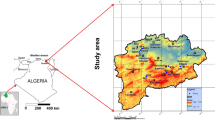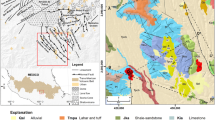Abstract
In this study environmental radioisotopes of water (3H and 14C) were used to determine the residence time of thermal waters. The temperature of geothermal waters was found to be uniform (57.6 °C ± 0.75 °C) with similar field alkalinity and pH values. The δ13C values of thermal water ranged between − 21.3 and − 18.75‰, which clearly reflect no/minimum contribution of carbonate minerals to the system. Environmental tritium concentration was found to be very low in these thermal waters indicating insignificant recharge from modern sources. The Pearson modelled 14C ages were found to vary from 4964 to 17,714 years.
Similar content being viewed by others
References
Barbier E, Fanelli M, Gonfiantini R (1983) Isotopes in geothermal energy exploration. IAEA Bull 25(2):31–36
Pandey OP, Negi JG (1995) Geothermal fields of India: a latest update. In: Proceedings of the world geothermal congress, 1995: Florence, Italy, pp 163–171
Pang Z (2005) Isotope techniques and geothermal resources management. In: Proceedings world geothermal congress, Antalya, Turkey, 24–29 April 2005
Kumar B, Han LF, Wassenaar LI, Klaus PM, Kainz GG, Hillegonds D, Brummer D, Ahmad M, Belachew DL, Araguás L, Aggarwal P (2016) A compact tritium enrichment unit for large sample volumes with automated re-filling and higher enrichment factor. Appl Radiat Isot 118:80–86. https://doi.org/10.1016/j.apradiso.2016.07.018
Plummer LN, Glynn P (2012) Radiocarbon dating in groundwater systems. In: Isotope Methods for Dating Old Groundwater, pp 33–89 https://www-pub.iaea.org/MTCD/Publications/PDF/Pub1587_web.pdf
Rama Sastri KS, Bhatia KKS, Bhism Kumar (eds) (2002) Chapter 1, Measurement of radiocarbon in natural water samples. In: Procedural manual (ver.1.0) measurement of radiocarbon and tritium in waters and cesium-137 & lead-210 in sediments. National Institute of Hydrology, Roorkee, pp 1–49
Lindholm GF (1996) Summary of the Snake river plain regional aquifer system analysis in Idaho and Eastern Oregon. In: USGS professional paper 1408-A. https://pubs.usgs.gov/pp/1408a/report.pdf
Thussu JL (2002) Geothermal energy resources of India. Geol Surv India Spec Pub 69:210
Ramakrishnan M, Nanda JK, Augustine PF (1998) Geological evolution of the Proterozoic Eastern Ghat Mobile Belt. Geol Surv India Special Publ 44:1–21
Chowdhury I, Ray B, Ali A (2011) Geology and mineral resources of Odisha. Geological Survey of India, Kolkata. Miscellaneous Publication No. 30, Part III—ODISHA, pp 1–74
Maitra A, Chatterjee A, Keesari T, Gupta S (2019) Forming topography in granulite terrains: evaluating the role of chemical weathering. J Earth Syst Sci. https://doi.org/10.1007/s12040-019-1293-4
Zimik HV, Farooq SH, Prusty P (2017) Geochemical evaluation of thermal springs in Odisha, India. Environ Earth Sci 76:593. https://doi.org/10.1007/s12665-017-6925-x
IAEA, Water Resources Programme (2010) Sampling procedure for isotope hydrology. http://www-naweb.iaea.org/napc/ih/documents/other/Sampling%20booklet%20web.pdf
Nair AR (1983) Possibilities of liquid scintillation counting for tritium and radio carbon measurements in natural water. In: Proceedings of the workshop on isotope hydrology. BARC, Mumbai, pp 41–56
Pinti D (2011) Chronological history of life on earth. In: Gargaud M et al. (eds) Encyclopedia of astrobiology. Springer, Berlin. https://doi.org/10.1007/978-3-642-11274-4
Sinha UK (2012) Application of isotope techniques to the assessment of aquifer system in urban centre, Ph.D. thesis submitted to Mumbai University
Mohokar HV, Pant D, Sinha UK, Joseph TB (2015) Inter-comparison test for the determination of low-level tritium activities in natural waters for age dating purposes. In: First DAE-BRNS symposium on current trends in analytical chemistry (CTAC-2015), 26–29 May 2015
Ground Water Year book (2016–2017) Central Ground Water Board, Ministry of Water Resources and Ganga Rejuvenation. South Eastern Region, Bhubaneswar, September 2017, p 237
International Atomic Energy Agency, Vienna (1983) Guidebook on Nuclear Techniques in Hydrology. Technical Reports Series No. 91, pp 1–457
Lucas LL, Unterweger MP (2000) Comprehensive review and critical of the half-life of tritium. J Res Nat Inst Stand Technol 105:541–549
Morgenstern U, Taylor CB (2009) Ultra Low-level tritium measurement using electrolytic enrichment and LSC. Isotope Environ Health S. 45:96–117
Shivanna K, Navada SV, Kulkarni KM, Sinha UK, Sharma S (1998) Application of Isotope Techniques to investigate Groundwater pollution in India. International Atomic Energy Agency (IAEA) Report, IAEA-TECDOC-1046, pp 167–184
Navada SV, Nair AR, Sharma S, Kulkarni UP, (1993) Geochemical and isotope studies of the geothermal areas of central and northern India. In: proceedings of the final research co-ordination meeting on the application of Isotope and Geochemical Techniques to Geothermal Exploration in the Middle East, Asia, the Pacific and Africa held in Dumaguete City, Philippines, IAEA-TECDOC-788
Robertson FN (1992) Radiocarbon dating of groundwater in a confined aquifer in Southeast Arizona. Radiocarbon 34(3):664–676
Taylor RE (2016) Radiocarbon dating: development of a nobel method. In: Schuur E, Druffel E, Trumbore S (eds) Radiocarbon and climate change. Springer, Basel. https://doi.org/10.1007/978-3-319-25643-6_2
Clark ID, Fritz P (1997) Environmental Isotopes in Hydrogeology. Lewis, New York, p 328
Vogel JC (1970) Carbon-14 dating of groundwater. In: Isotope hydrology. IAEA symposium 129, Vienna, pp 225–239
Tamers MA (1975) The validity of radiocarbon dates on groundwater. Geophys Surv 2:217–239
Fontes JC, Garnier JM (1979) Determination of the initial 14C activity of the total dissolved carbon: a review of the existing models and a new approach. Water Resour Res 15:399–413
Plummer NL, Prestemon EC, Parkhurst DL (1991) An interactive code (NETPATH) for modeling NET geochemical reactions along a flow PATH, version 20. Water Resour Investig Rep 94:4169. https://doi.org/10.3133/wri944169
Aggarwal PK, Araguás-Araguás L, Choudhry M, Michel VD, Froehlich K (2013) Lower groundwater C-14 Age by atmospheric CO2 uptake during sampling and analysis. Groundwater 52(1):20–24. https://doi.org/10.1111/gwat.12110
Wood WW, Low WH (1988) Solute geochemistry of the Snake River Plain regional aquifer system, Idaho and eastern Oregon. Professional Paper 1408-D. https://doi.org/10.3133/pp1408D
Kalaga DV, Kulkarni AV, Acharya R, Kumar U, Singh G, Joshi JB (2009) Some industrial applications of gamma-ray tomography. J Taiwan Inst Chem Eng 40:602–612
Keesari T, Roy A, Mohokar H, Pant D, Sinha UK (2019) Characterization of mechanisms and processes controlling groundwater recharge and its quality in drought prone region of Central India using isotope hydrochemical and end member mixing modeling. Natl Resour Res. https://doi.org/10.1007/s11053-019-09550-0
Keesari Tirumalesh, Diana AS, Madhuri SR, Pant Diksha, Mohokar HV, Jaryal Ajay, Sinha UK (2017) Isotope investigation on groundwater recharge and dynamics in shallow and deep alluvial aquifers of southwest Punjab. Appl Radiat Isot 129:163–170
Diana AS, Tirumalesh K, Madhuri SR, Diksha P (2018) A study on the role of hydrogeology on the distribution of uranium in alluvial aquifers of northwest India. Environ Monitor Assess 190(12):746. https://doi.org/10.1007/s10661-018-7112-6
Tirumalesh K, Uday KS (2019) Paleo-seawater of Kutch region, Gujarat. Curr Sci 116(8):1–4
Sharma OP (2017) Geothermal energy in India: current status and future dimensions. In: Chandel A, Sukumaran R (eds) Sustainable biofuels development in India. Springer, Cham, pp 73–85. https://doi.org/10.1007/978-3-319-50219-9
Chatterjee S, Gusyev MA, Sinha UK, Mohokar HV, Dash A (2019) Understanding water circulation with tritium tracer in the Tural-Rajwadi geothermal area, India. Appl Geochem 109:104373. https://doi.org/10.1016/j.apgeochem.2019.104373
Chatterjee S, Sinha UK, Biswal BP, Jaryal A, Jain PK, Patbhaje S, Dash A (2019) An integrated isotope-geochemical approach to characterize a medium enthalpy geothermal system in India. Aquat Geochem 25(2019):63–89. https://doi.org/10.1007/s10498-019-09352-z
Dacillo D, Salonga N (2005) Conceptual flow patterns from stable isotope systematics of the Mahanagdong geothermal field, Philippines. In: Pang Z, Truesdell A (eds) 2005, Special Issue of isotope techniques in geothermal investigations. Geothermics
Acknowledgements
Authors sincerely acknowledge the constant support and encouragement by Dr. P.K. Pujari Associate Director, Radiochemistry and Isotope Group, Bhabha Atomic Research Centre, Mumbai. The authors are also grateful to officers of the GSI, Nagpur for their support in sampling.
Author information
Authors and Affiliations
Corresponding author
Additional information
Publisher's Note
Springer Nature remains neutral with regard to jurisdictional claims in published maps and institutional affiliations.
Rights and permissions
About this article
Cite this article
Keesari, T., Chatterjee, S., Pant, D. et al. Dating of hot springs at Attri, Tarabalo and Athmalik sites in Odisha, India using radiocarbon technique. J Radioanal Nucl Chem 323, 1227–1235 (2020). https://doi.org/10.1007/s10967-019-06867-1
Received:
Published:
Issue Date:
DOI: https://doi.org/10.1007/s10967-019-06867-1







